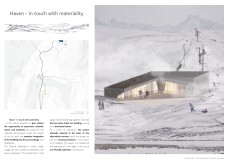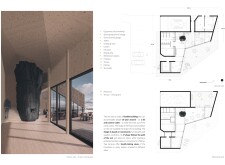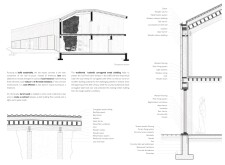5 key facts about this project
## Project Overview
Haven is located in a rugged, icy landscape in Iceland, characterized by heathlands and sparse grasslands. This design aims to respond to the unique geographical and climatic conditions while serving as a multifunctional hub for summer and winter outdoor activities. It caters specifically to visitors engaged in skiing and other recreational pursuits, providing a space that integrates with its natural surroundings.
## Materiality and Sustainability
The architectural design employs a range of locally sourced materials, focusing on durability and environmental sustainability. Lava-based concrete forms the core structural element, significantly reducing carbon emissions in comparison to traditional concrete. Burnt wood cladding enhances aesthetic appeal and durability, while Icelandic corrugated metal roofing ensures resilience against harsh weather. Large glass expanses are incorporated to maximize natural light and create a visual connection with the exterior landscape.
The building also features a central lava stone, serving both structural and metaphorical roles, anchoring the design to the site and reflecting the region's geological identity. Interior spaces utilize light-colored wood and black rock, fostering a warm atmosphere that contrasts with the rugged exterior.
## Spatial Strategy and Design Outcomes
The design follows a V-shaped layout, optimizing solar access and facilitating user flow. High ceilings and open spaces contribute to an inviting environment, while flexible multi-functional areas accommodate a range of activities such as workshops and rest zones. A prominent lava rock fireplace serves as a focal point, enhancing the cozy ambience.
The organization of spaces effectively addresses operational needs, with technical rooms and storage areas positioned to promote efficiency. A mezzanine level provides additional viewing and relaxation opportunities, enhancing the overall user experience while maintaining a connection to the stunning landscape.
The integration of rain barriers, advanced insulation systems, and comprehensive drainage solutions ensures durability and environmental responsibility, aligning with contemporary sustainable building practices.





















































